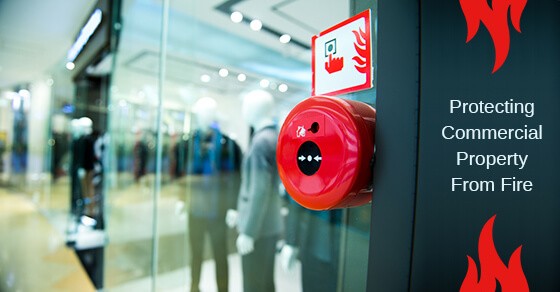You may think of the workplace as a safe environment, and generally, it is. But did you know that fire is the biggest safety hazard in a commercial building? In fact, fire is the number-one cause of all deaths that happen in the workplace, according to OSHA. Keeping employees and tenants safe in a place of business is your top priority, but protecting your property, stock, and machinery is also important.
To save lives and reduce the chance of business losses, follow these tips to ensure your business is protected in case of a fire.
1. Practice Prevention
Taking all of the proper steps to prevent a fire from starting in the first place will dramatically reduce your chances of experiencing one. Remember that fire needs three things: heat, fuel, and oxygen. Look around your office and see where/if those three things might come into contact with each other. A pile of napkins sitting next to a coffee maker with a faulty electrical cord is a prime example of an office fire hazard that’s easy to overlook.
Some actionable fire prevention tasks include:
- Install kitchen hood systems and kitchen fire systems in break rooms as appropriate
- Do not use extension cords as a permanent solution
- Unplug small appliances, such as coffee makers, at the end of the day
- Minimize clutter in the office, especially paper clutter
- Store combustible materials as recommended by the manufacturer
- Do not use appliances with frayed or outdated cords
- Do not allow the use of candles or space heaters in the building
Ask your local fire department what other steps they recommend for fire safety in your area. Scheduling a risk assessment evaluation from an experienced professional is also a good idea for identifying and reducing fire risks.
2. Have an Evacuation Plan
Even when you take all of the right precautions, fires can still happen. Protect your employees and customers during a fire emergency by having a clear evacuation plan. Teach employees about their nearest emergency exits and alternative paths to reach those exits. Make sure to follow all OSHA guidelines regarding fire exits and the proper use of signage needed to lead people safely from the building.
3. Appoint a Fire Safety Officer
Every building should have at least one fire safety officer. To fulfill their responsibilities, a fire safety officer should:
- Know the evacuation plan
- Know where fire extinguishers are located and how to use them
- Train staff on evacuation procedures and the use of all safety equipment
- Check fire alarms regularly
- Run periodic safety drills
- Test the fire alarm system and schedule maintenance as needed
The fire safety officer should also keep documentation on all of the procedures, fire safety equipment maintenance, and dates of fire drills. If your business is in a multi-floor building or is one of several businesses in a commercial building, each floor and each business should appoint their own safety officer.
4. Install a Fire Sprinkler/Suppression System
If a fire should occur when the building is uninhabited, a fire suppression system provides the best chance to stop it before it causes major damage. If you choose to put in a suppression system, follow all regulations for installation and maintenance. In water-sensitive environments such as a server room, dry fire-suppression systems may be substituted.
Recap for Safety
A fire in your place of business could be devastating financially and emotionally. Installing fire alarms, kitchen fire systems, proper signage, and other emergency equipment is more than just a good idea. These simple steps could save the lives of your employees, visitors, and customers.

